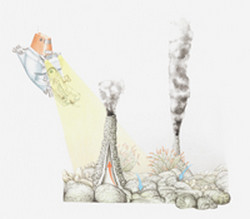How hydrothermal vents support life
Deep-ocean hydrothermal vents are fissures in the Earth's surface from which geothermally heated water loaded with metals escapes. Many vent sites in the area of the Mid-Atlantic Ridge are home to the shrimp species Rimicaris exoculata. These creatures graze on sulphides from hydrothermal chimneys and contain symbiotic bacteria. The bacteria live within the shrimps' respiratory and digestive systems and can oxidise hydrogen sulphide or methane emitted at the vent sites. The iron minerals ferric oxyhydroxide and ferrihydrite were recently discovered in the gill chambers of R. exoculta. This indicates that iron-oxidising as well as sulphide-oxidising symbiotic bacteria could be involved in the metabolism of creatures living around the vents. The EU-funded 'Iron geobiology at deep-ocean hydrothermal vents' (IRONGEOBIOVENT) project investigated the phenomena. Researchers' first objective was to better understand how the shrimps gained their energy by measuring iron isotopes. Over the last decade this method has grown in use for achieving an understanding of biogeochemical cycles. The technique represented a new tool for investigating complex interactions between microbial activity, biogeochemical processes and iron redox cycling around hydrothermal vents. The project's second objective was to gain a better understanding of the microbial pathways for iron in hydrothermal systems. This was done by measuring the iron isotropic composition of the iron minerals found within the shrimps and selected samples of hydrothermal fluids and sulphides. IRONGEOBIOVENT represents a successful transfer of knowledge from the field of isotope geochemistry to the field of geobiology. The project's results will provide a greater understanding of the biological communities surrounding deep-ocean hydrothermal vents and how they metabolise the minerals the vents produce.







